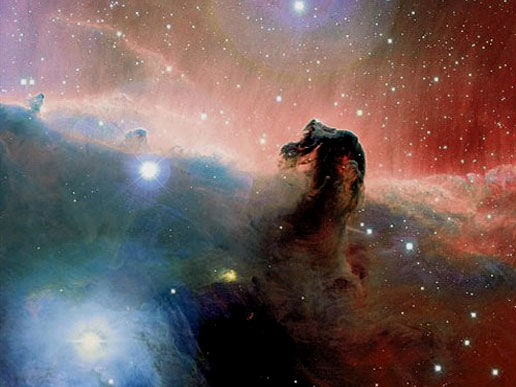Stardust
Along with the introduction of dust into the universe came large aggregates of dust organized by gravity, which are the asteroids, moons, and rocky earth-like planets. Some of the dust still swirls and eddies along with the gases as tiny particles in great galactic clouds called nebulae. Large collections of these nebulae orbit along with stars around common central points of gravity. These giant collectives are of course the galaxies. The dustiest area of the Milky Way Galaxy is along the galactic plane, in which our solar system is embedded. Away from the plane, up above and below, there appear to be isolated clouds of gas and dust scattered about. These high latitude dust bunnies are difficult to detect. They tend to be too cold to be glowing with visible light. They are typically only 15 to 17 degrees above absolute zero, which is very cold, but it is still warmer than the background radiation of space, which is about 2.7 degrees Kelvin. Finding and cataloging cold dark dust clouds in our galaxy is a challenging part of astronomy.
Amateur astronomers who swear to having seen the Horse Head are sometimes said to be members of the liars club. This is because seeing it is so difficult that, except under the most perfect conditions, it is impossible. So much is required to see the faint ghostly image; large telescopes (18 or more inches diameter), a transparent sky, very still air, a high quality eyepiece, a nebula filter (O3), good dark adapted eyes, and not least - an experienced observer. Detecting faint dark dust clouds doesn't have to be left to the liar's club. The discrepancy between a stars intrinsic color and its apparent color, i.e. the degree of reddening, can be calculated, thus betraying the presence and density of an intervening dust cloud. But at high galactic latitudes the clouds are small and widely scattered, making the calculation for hundreds of thousands of stars across the vast expanse of sky a daunting task. Dust clouds cause a certain amount of extinction of starlight that passes through them, especially at the higher (blue) wavelengths. Put another way, interstellar dust particles extinguish light more efficiently at short wavelengths than at long wavelengths. Having attenuated the light more in the blue region than the red, we say that the cloud has reddened the starlight. Stated succinctly, the extinction coefficient (Qλ) goes as the radius of the dust grains and inversely as the wavelength of the incident light, Qλ ~ r/λ. There are exceptions at certain wavelengths due to the atomic composition of the dust and energy resonance, but the mean result is that the color (surface temperature) of stars can appear redder (cooler) than their actual value. The discrepancy can be detected by considering the absorption/emission lines in the star's spectrum. Understanding interstellar dust is important in many fields of astronomy. Accounting for the degree of stellar reddening caused by dust is crucial in astronomical fields that rely on photometry, such as cosmology and other extra-galactic sciences. These disciplines involve mathematical models that are very sensitive to the small discrepancies in the intensity of starlight that is caused by dust. |

